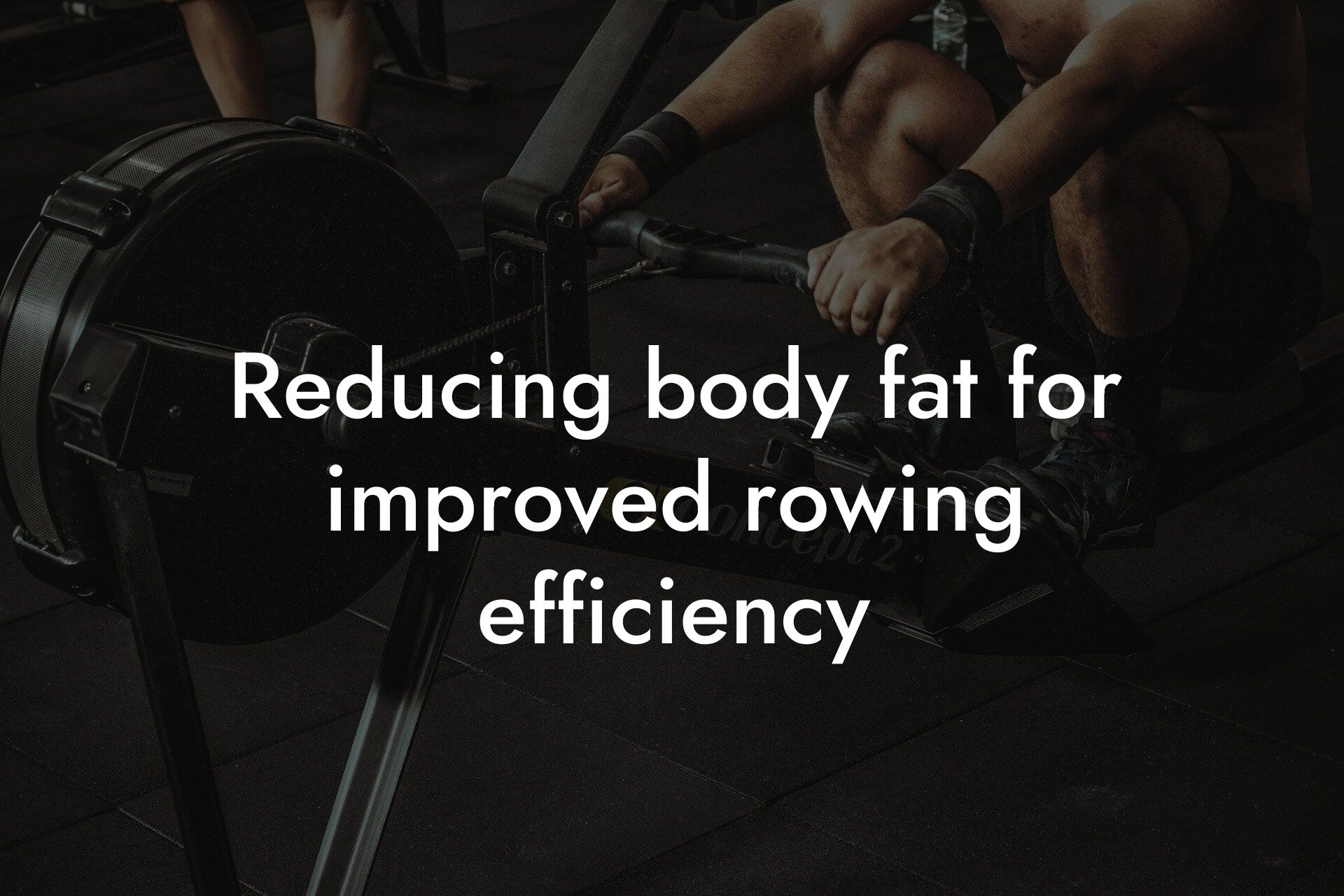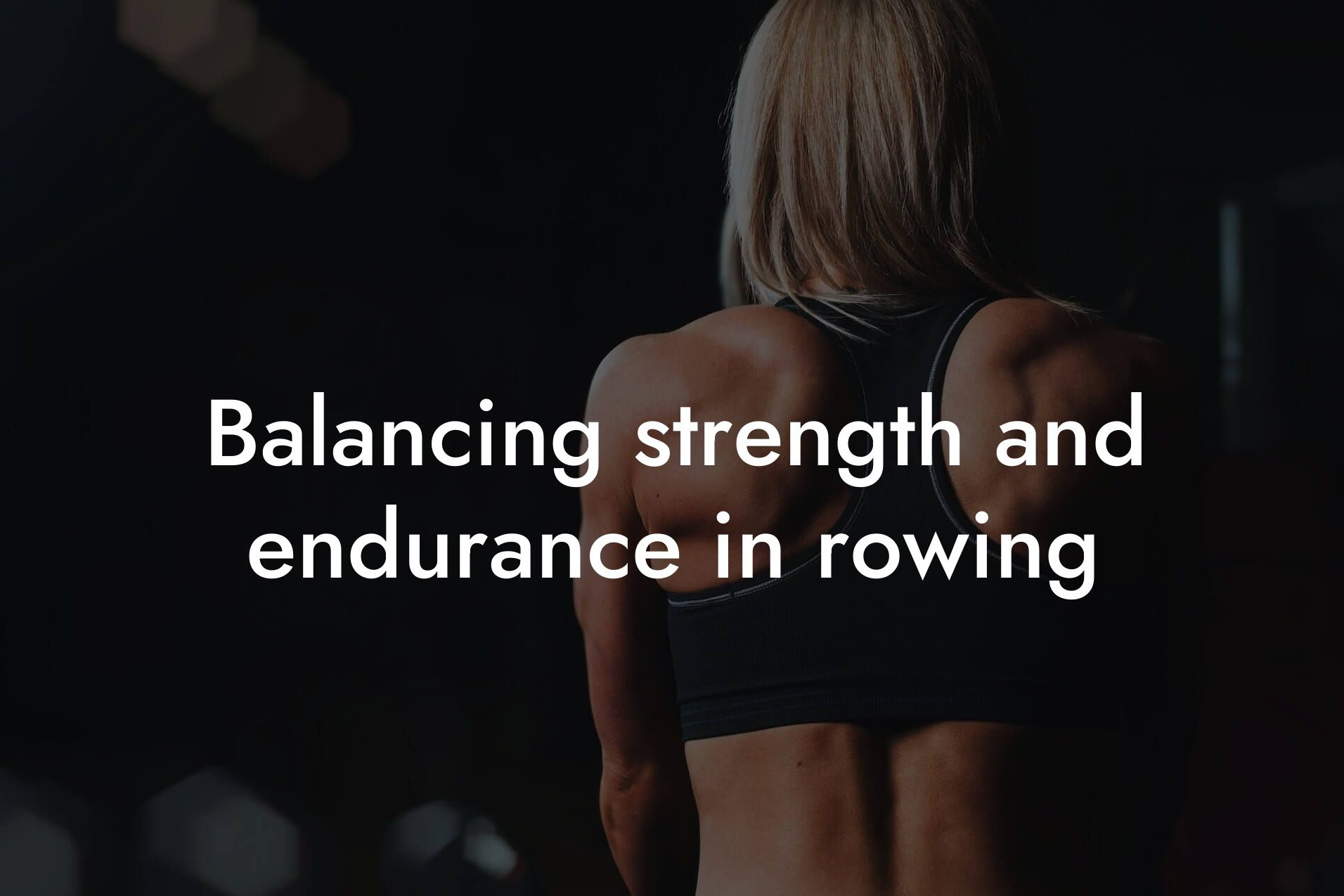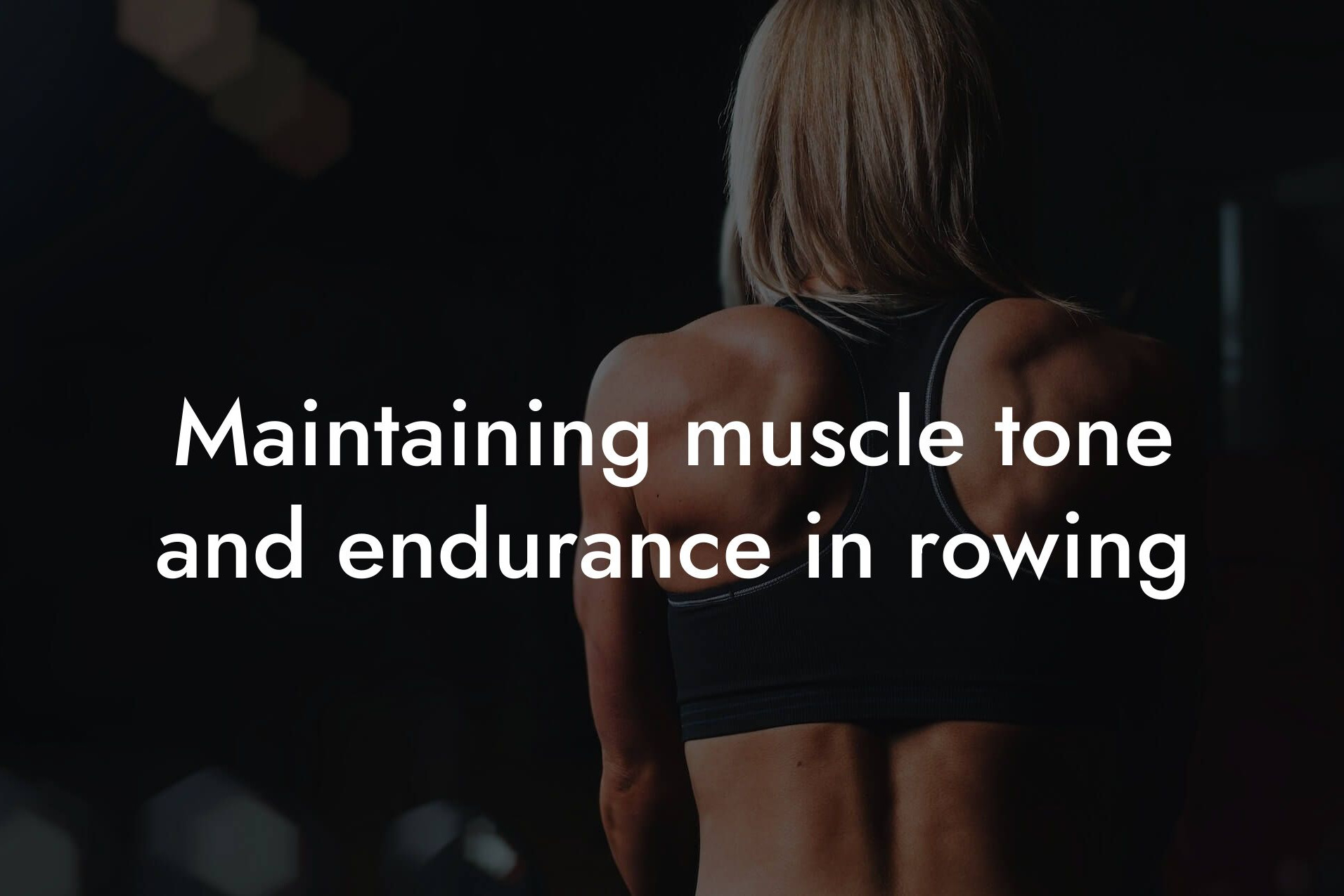As a high-earning professional, taking care of your physical appearance and overall health is crucial for maintaining a competitive edge in your career. Rowing is an excellent way to stay fit and healthy, but intense rowing sessions can take a toll on your body. Proper recovery techniques are essential to help your body repair, rebuild, and adapt to the physical demands of rowing. In this article, we'll explore the best recovery techniques for rowers after intense sessions, helping you optimize your performance and achieve your fitness goals.
Table of Contents
Why Recovery is Crucial for Rowers
Rowing is a high-intensity sport that requires a combination of strength, endurance, and technique. Intense rowing sessions can cause micro-tears in your muscles, leading to inflammation and soreness. If you don't allow your body sufficient time to recover, you may experience decreased performance, fatigue, and increased risk of injury. Proper recovery techniques help to reduce muscle soreness, improve flexibility, and enhance overall performance.
Immediate Post-Rowing Recovery Techniques
After an intense rowing session, it's essential to focus on immediate recovery techniques to help your body start the repair process. Here are some techniques to incorporate into your post-rowing routine:
1. Stretching: Gentle stretching can help reduce muscle soreness and improve flexibility. Focus on stretching your major muscle groups, including your legs, back, and arms.
2. Hydration: Drink plenty of water or a sports drink to replenish lost fluids and electrolytes. Aim to consume at least 16-20 ounces of fluid for every pound of body weight lost during exercise.
3. Protein Shake: Consuming a protein shake within 30-60 minutes after exercise can help promote muscle repair and recovery. Aim for 15-20 grams of protein from a source like whey or casein.
4. Compression Garments: Wearing compression clothing, such as tights or sleeves, can help improve blood flow and reduce muscle soreness.
Delayed Onset Muscle Soreness (DOMS)
Delayed onset muscle soreness (DOMS) is a common phenomenon experienced by rowers, typically occurring 24-48 hours after intense exercise. DOMS is characterized by muscle pain, stiffness, and tenderness, making it challenging to perform daily activities, let alone row. To alleviate DOMS, try the following techniques:
1. Foam Rolling: Use a foam roller to gently roll out your muscles, focusing on areas like your IT band, quadriceps, and hamstrings.
2. Massage: Treat yourself to a massage or use a self-massage tool to help reduce muscle tension and promote relaxation.
3. Heat and Cold Therapy: Apply heat or cold packs to the affected area to reduce pain and inflammation. Heat therapy, such as a warm bath or shower, can help relax muscles, while cold therapy, like an ice pack or cold compress, can help reduce inflammation.
Active Recovery Techniques
Active recovery techniques involve low-intensity exercises that promote blood flow and help your body recover from intense rowing sessions. Try incorporating the following activities into your recovery routine:
1. Light Cardio: Engage in low-intensity cardio exercises like cycling, swimming, or using a stationary bike to promote blood flow and aid in the removal of waste products.
2. Yoga or Pilates: Practice gentle yoga or Pilates exercises to improve flexibility, balance, and core strength.
3. Walking or Jogging: Take a leisurely walk or jog to help promote blood flow and aid in the recovery process.
Nutrition for Recovery
A well-balanced diet is essential for optimal recovery. Focus on consuming a diet rich in protein, complex carbohydrates, and healthy fats. Here are some nutrition tips to support your recovery:
1. Protein-Rich Foods: Include protein-rich foods like lean meats, fish, eggs, dairy, and plant-based options like beans, lentils, and tofu in your diet.
2. Complex Carbohydrates: Focus on complex carbohydrates like whole grains, fruits, and vegetables, which provide sustained energy and support muscle recovery.
3. Healthy Fats: Include healthy fats like nuts, seeds, avocados, and olive oil in your diet to support hormone production and overall health.
Sleep and Rest for Recovery
Adequate sleep and rest are crucial for recovery. During sleep, your body repairs and rebuilds damaged muscle tissue, making it essential for optimal recovery. Aim for 7-9 hours of sleep each night and prioritize rest days as needed.
Monitoring Your Progress with DEXA Scans
At Tano Performance Group, we understand the importance of tracking your progress and making data-driven decisions to optimize your performance. Our DEXA scans provide a comprehensive body assessment, giving you valuable insights into your body composition, bone density, and overall health. By regularly tracking your progress with DEXA scans, you can:
1. Monitor Body Composition: Track changes in your body fat percentage, lean mass, and bone density to optimize your nutrition and training plan.
2. Identify Areas for Improvement: Use DEXA scan data to identify areas for improvement, such as muscle imbalances or bone density concerns, and adjust your training program accordingly.
3. Optimize Your Training Plan: Use DEXA scan data to optimize your training plan, ensuring you're targeting the right areas and making progress towards your fitness goals.
By incorporating these recovery techniques into your routine, you'll be able to optimize your performance, reduce muscle soreness, and achieve your fitness goals. Remember to prioritize rest, nutrition, and monitoring your progress with DEXA scans to take your rowing performance to the next level.
Frequently Asked Questions
What is the importance of recovery techniques for rowers after intense sessions?
Recovery techniques are crucial for rowers after intense sessions as they help to reduce muscle soreness, improve flexibility, and enhance overall performance. Proper recovery techniques can also prevent injuries, reduce fatigue, and promote faster adaptation to training. At Tano Performance Group, we understand the importance of recovery and provide guidance on the best techniques to support high-earning professionals in achieving their physical goals.
What are some common signs of poor recovery in rowers?
Common signs of poor recovery in rowers include persistent muscle soreness, fatigue, decreased performance, and increased risk of injury. Additionally, poor recovery can lead to mood disturbances, decreased motivation, and impaired sleep quality. If you're experiencing any of these symptoms, it's essential to reassess your recovery strategy and incorporate effective techniques to support your training.
What is the optimal window for recovery after an intense rowing session?
The optimal window for recovery after an intense rowing session is within 30-60 minutes post-exercise. During this time, your body is most receptive to nutrient uptake, and your muscles are most responsive to stretching and foam rolling. Make the most of this window by incorporating recovery techniques such as protein shakes, stretching, and self-myofascial release.
What role does nutrition play in recovery for rowers?
Nutrition plays a critical role in recovery for rowers. Consuming a balanced meal or snack that includes protein, complex carbohydrates, and healthy fats within 30-60 minutes post-exercise can help promote muscle repair, replenish energy stores, and support immune function. Additionally, staying hydrated by drinking plenty of water or a sports drink can help reduce muscle cramping and fatigue.
What are some effective nutrition strategies for rowers during recovery?
Effective nutrition strategies for rowers during recovery include consuming a post-workout shake with 15-20 grams of protein, eating a balanced meal with complex carbohydrates and lean protein within 60 minutes post-exercise, and staying hydrated by drinking at least 8-10 glasses of water per day. Additionally, incorporating anti-inflammatory foods such as omega-3 rich fish, turmeric, and ginger can help reduce muscle inflammation and promote recovery.
How does stretching benefit rowers during recovery?
Stretching is an essential component of recovery for rowers as it helps to improve flexibility, reduce muscle soreness, and promote relaxation. Focus on static stretches that target the major muscle groups used in rowing, such as the latissimus dorsi, rhomboids, and quadriceps. Hold each stretch for 20-30 seconds and breathe deeply, feeling the stretch in your muscles.
What is the importance of foam rolling in recovery for rowers?
Foam rolling is a self-myofascial release technique that helps to reduce muscle soreness, improve circulation, and promote relaxation. By applying gentle pressure to specific areas of tension, foam rolling can help to break up adhesions and scar tissue, reducing muscle stiffness and improving range of motion. Focus on rolling your IT band, quadriceps, and hamstrings to target the major muscle groups used in rowing.
Can compression garments aid in recovery for rowers?
Compression garments can aid in recovery for rowers by improving circulation, reducing muscle soreness, and promoting relaxation. By providing gentle compression to the muscles, compression garments can help to reduce swelling and improve lymphatic drainage, promoting faster recovery. Look for garments with graduated compression that provide more compression at the extremities than at the core.
How does cryotherapy benefit rowers during recovery?
Cryotherapy, or ice baths, can benefit rowers during recovery by reducing muscle inflammation, improving circulation, and promoting relaxation. By immersing yourself in cold water (around 50-55°F) for 10-15 minutes, you can help to reduce muscle soreness and inflammation, making it an effective recovery technique for rowers.
What is the role of sleep in recovery for rowers?
Sleep plays a critical role in recovery for rowers as it allows your body to repair and adapt to the physical demands of training. During sleep, your body repairs and rebuilds muscle tissue, consolidates memories, and releases hormones that support growth and recovery. Aim for 7-9 hours of sleep per night to support optimal recovery.
How can rowers optimize their sleep environment for better recovery?
Rowers can optimize their sleep environment for better recovery by creating a dark, quiet, and cool sleep space. Invest in blackout curtains, earplugs, or a white noise machine to create an ideal sleep environment. Additionally, keep your bedroom cool (around 60-67°F) and invest in a comfortable mattress and pillows to support better sleep quality.
What is the importance of mental recovery for rowers?
Mental recovery is essential for rowers as it allows them to recharge, refocus, and prepare for their next training session. Mental recovery techniques such as meditation, visualization, and positive self-talk can help to reduce stress, improve mood, and enhance overall performance. Make time for mental recovery by incorporating these techniques into your daily routine.
How can rowers incorporate mindfulness into their recovery routine?
Rowers can incorporate mindfulness into their recovery routine by practicing meditation, deep breathing exercises, or yoga. These techniques can help to reduce stress, improve focus, and promote relaxation. Start with short sessions (5-10 minutes) and gradually increase the duration as you become more comfortable with the practice.
What is the role of self-myofascial release in recovery for rowers?
Self-myofascial release, or foam rolling, plays a critical role in recovery for rowers by reducing muscle tension, improving circulation, and promoting relaxation. By applying gentle pressure to specific areas of tension, self-myofascial release can help to break up adhesions and scar tissue, reducing muscle stiffness and improving range of motion.
How can rowers incorporate self-myofascial release into their recovery routine?
Rowers can incorporate self-myofascial release into their recovery routine by dedicating 10-15 minutes per day to foam rolling. Focus on rolling your IT band, quadriceps, and hamstrings to target the major muscle groups used in rowing. Start with gentle pressure and gradually increase the intensity as you become more comfortable with the technique.
What is the importance of active recovery for rowers?
Active recovery is essential for rowers as it allows them to maintain cardiovascular fitness, improve circulation, and promote relaxation. Active recovery techniques such as cycling, swimming, or rowing at a low intensity can help to reduce muscle soreness, improve mood, and enhance overall performance. Incorporate active recovery into your routine 1-2 times per week to support optimal recovery.
How can rowers incorporate active recovery into their training routine?
Rowers can incorporate active recovery into their training routine by dedicating 1-2 sessions per week to low-intensity exercise. Choose an activity that you enjoy, such as cycling or swimming, and aim for 30-60 minutes of gentle exercise. This can help to reduce muscle soreness, improve circulation, and promote relaxation.
What is the role of massage in recovery for rowers?
Massage plays a critical role in recovery for rowers by reducing muscle tension, improving circulation, and promoting relaxation. By applying gentle pressure to specific areas of tension, massage can help to break up adhesions and scar tissue, reducing muscle stiffness and improving range of motion. Incorporate massage into your recovery routine 1-2 times per month to support optimal recovery.
How can rowers incorporate massage into their recovery routine?
Rowers can incorporate massage into their recovery routine by scheduling regular massage sessions with a licensed therapist. Focus on areas of tension, such as the IT band, quadriceps, and hamstrings, and communicate with your therapist about any areas of discomfort. You can also incorporate self-massage techniques, such as foam rolling, into your daily routine to support optimal recovery.
What is the importance of gradual progression in training for rowers?
Gradual progression in training is essential for rowers as it allows them to adapt to the physical demands of training, reducing the risk of injury and improving overall performance. Gradually increase the intensity, duration, and frequency of your training sessions to allow your body to adapt and recover.
How can rowers incorporate gradual progression into their training routine?
Rowers can incorporate gradual progression into their training routine by increasing the intensity, duration, or frequency of their training sessions by 10-15% each week. This allows your body to adapt to the physical demands of training, reducing the risk of injury and improving overall performance. Listen to your body and adjust your training routine accordingly to support optimal recovery and performance.
What is the role of recovery in preventing overtraining in rowers?
Recovery plays a critical role in preventing overtraining in rowers by allowing their body to adapt to the physical demands of training. Overtraining can lead to fatigue, decreased performance, and increased risk of injury. By incorporating effective recovery techniques into their routine, rowers can reduce the risk of overtraining and support optimal performance.
How can rowers recognize the signs of overtraining?
Rowers can recognize the signs of overtraining by monitoring their body's response to training. Common signs of overtraining include persistent fatigue, decreased performance, increased muscle soreness, and mood disturbances. If you're experiencing any of these symptoms, it's essential to reassess your training routine and incorporate more recovery days to support optimal recovery and performance.
Here are some related articles you might love...
- Reducing body fat for improved rowing efficiency
- Balancing strength and endurance in rowing
- Maintaining muscle tone and endurance in rowing
- How body composition impacts rowing performance
- The role of rowing in cardiovascular health
- Strength training tips to complement your rowing routine
- Using DEXA scans to monitor progress in rowing
- Bone density and its role in rowing performance
- Nutrition strategies for sustained energy during rowing workouts
Zak Faulkner
Zak Faulkner is a leading authority in the realm of physical health and body composition analysis, with over 15 years of experience helping professionals optimise their fitness and well-being. As one the experts behind Tano Performance Group, Zak has dedicated his career to providing in-depth, science-backed insights that empower clients to elevate their physical performance and overall health.
With extensive knowledge of DEXA technology, Zak specializes in delivering comprehensive body assessments that offer precise data on body fat, muscle mass, bone density, and overall physique. His expertise enables individuals to make informed decisions and achieve their fitness goals with accuracy and confidence. Zak’s approach is rooted in a deep understanding of human physiology, combined with a passion for helping clients unlock their full potential through personalised strategies.
Over the years, Zak has earned a reputation for his commitment to excellence, precision, and client-focused service. His guidance is trusted by top professionals who demand the best when it comes to their health. Whether advising on fitness programs, nutritional strategies, or long-term wellness plans, Zak Faulkner’s insights are a valuable resource for anyone serious about taking their health and fitness to the next level.
At Tano Performance Group, Zak continues to lead our Content Team revolutionising how professionals approach their physical health, offering unparalleled expertise that drives real results.




